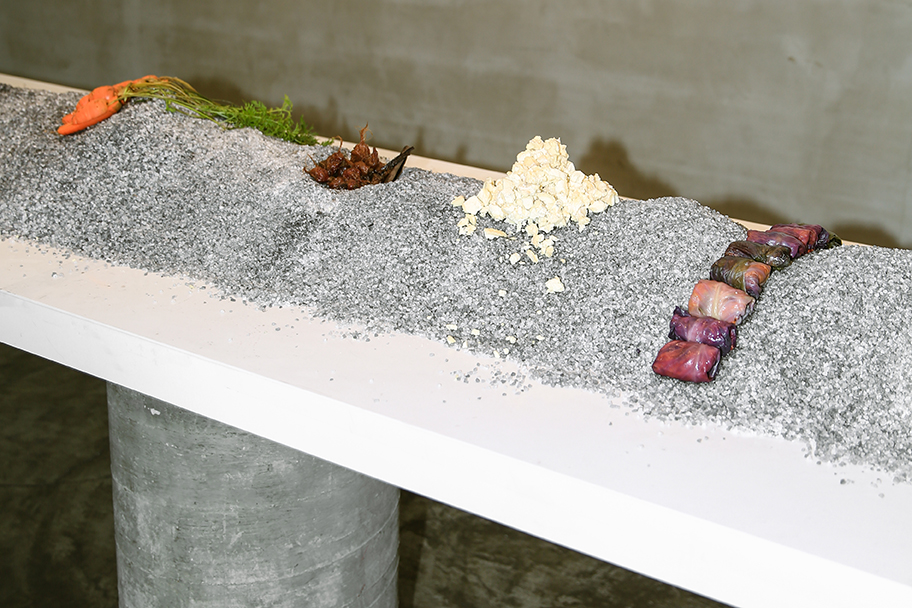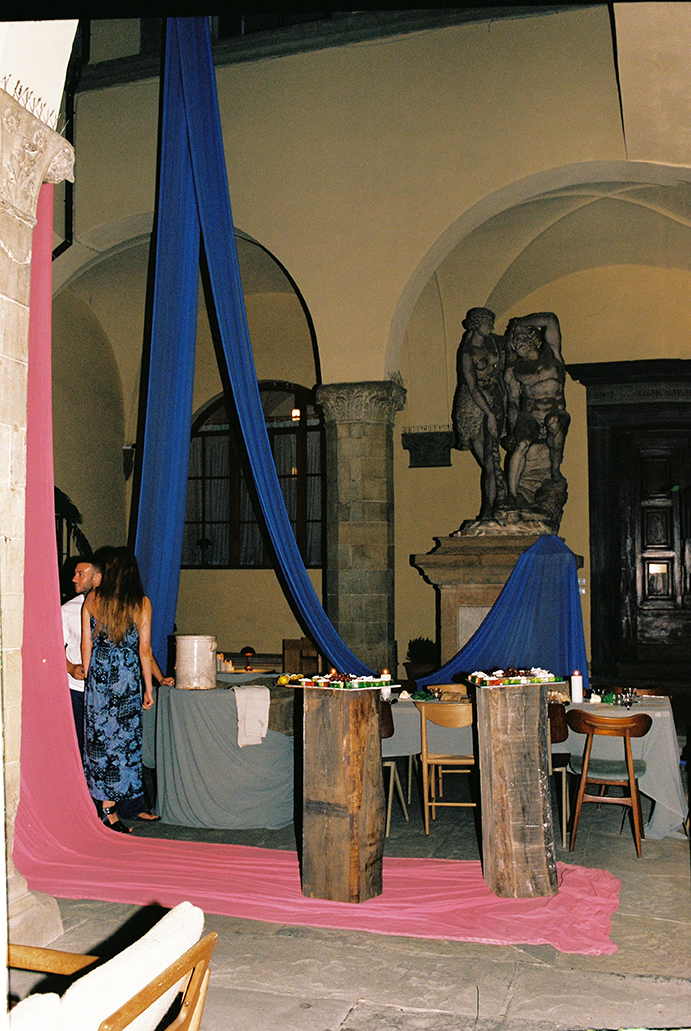Ananas Ananas presented an edible installation showcasing the carbon footprint during the food production of the daily consumption for each person gathered in the room (20). The 440 pounds of sea salt represented the amount of soil that gets eroded and gone forevermore. Life and the world are made up of relationships: between beings, circumstances, and ideas. Of all the significant relationships, perhaps the most important that we develop with the environment is the relationship with the fertile land. In a way, this speaks to the fact that the earth has taught us everything we know about cycles and time, and during the modern development of humanity (linked to the discovery of agriculture) we were referred to as beings of the earth. The co-belonging between the soil resource and the world shows that its benefits must also be linked to the prerogative that it is necessary to redeem it. As a result of soil erosion, over the past 40 years, about 30% of the world's farmland has been rendered unproductive and much of it has been abandoned for cultivation. This gradual deterioration generated by phenomena of physical and chemical erosion and unlimited exploitation of the soil through technology ends up removing the possibility of the soil losing its hermetic condition. Productive land is an impenetrable nature. Its material image immediately transcends sensations and roots effectively in the deepest layers of the unconscious. The land is what is essentially closed, and therefore needs to be tilled and worked, it limits its access superficially; the earth bursts into the world and destroys any attempt to meddle in it. Global agriculture is responsible for around three-quarters of soil erosion worldwide. The most important non-renewable geological resource is fertile soil. Soil is an ancient body made up of layers of organic matter, air, and water. It is estimated that 24 billion tons of fertile soil are lost each year due to erosion. The implications of its degradation threaten future food security, due to the significant reduction in its productivity. The soil resource is a mediating element of human experience, which immediately determines food and permanence, its durability compromises the transformation of the world. - Hebe Garibay
Menu:
Purple cabbage dolma
Sweet crispy rainbow chard
Radish jam
Pickled carrots
Beet stem galette
Materials:
Sea salt
Charcoal
Eating goes beyond a cultural and political act, it is a necessity beyond whim. However, we do little to assimilate certain ethical understandings about our relationship with food. Through an edible installation, a tangible reflection is made about the respect for natural resources and their future. Do we produce more or waste less? Ananas Ananas addresses issues around the food production chain, specifically the amount of water and soil going to waste with our residues left unwanted. By illustrating the similarities and the ways we use and abuse resources, we are asking ourselves if we’re taking what we want or what we need.
SALT 2,640 pounds of eroded soil from unsustainable farming is represented by sea salt. This is the collective amount of infertile soil that is no longer useful by the consumption of a single meal from each person attending tonight. FOUR OLIVES 125L The liters of water used to produce 4 pickled olives represented by the glass vessels. ONE APPLE 70L ONE ORANGE 50L FIVE BLUEBERRIES 20L The liters of water used to produce each fruit represented by gelatin and up-cycled water.
Eating goes beyond a cultural and political act, it is a necessity beyond whim. However, we do little to assimilate certain ethical understandings about our relationship with food. Through food waste and reclaimed elements, a tangible reflection is made about the respect for raw materials, natural resources and their future. Do we produce more or waste less? This is our first approach in addressing issues around the production chain, specifically the amount of water going to waste with our residues left unwanted. By illustrating the similarities and the ways we use and abuse resources, we are asking ourselves if we’re taking what we want or what we need.
4 OLIVES EQUALS
The 125 liters of water used to produce 4 pickled olives represented by glass drinking vessels.
1 POTATO EQUALS
The food production chain showcased by black clay bowls holding gelatin and up-cycled water equivalent to the 25 liters it takes to produce one potato.
1 APPLE (70L), 1 ORANGE (50L), 5 BLUEBERRIES EQUALS (20L)
Food waste immersed in gelatin shapes and up-cycled water show the amount of water it takes to produce each piece of fruit, sustained by reclaimed elements from utilitarian design practices.
Wooden objects: En La Superficie
Performance art & curatorial text: Regina Hoyos
Cement bowls: Tierra Piedra
: the capacity to experience feelings and sensations. Although we are gifted with this feature, we often choose to hide it away. This dinner exhibition is a representation of these feelings and sensations, the journey in which they fluctuate between the pleasant and the unpleasant. Acknowledging our spirit in all forms, because a light can only shine in the dark.
Menu:
Watermelon, olives, feta
Bread, butter, herbs
Saffron chicken
Vegetable dolma
Cold yogurt soup
Olive oil cake, strawberry jam, ricotta
Materials:
Pink, purple and turquoise fabric
Galvanized wire
Plywood
Wooden platforms
Ceramic tiles



